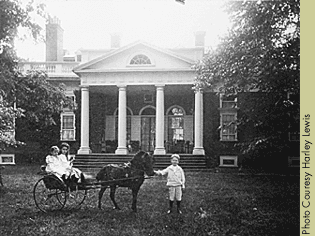November 2023
Saving Monticello: The Newsletter
The latest about the book, author events, and more
Newsletter Editor - Marc Leepson
Volume XX, Number 11 November 2023
“The study of the past is a constantly evolving,never-ending journey of discovery.” – Eric Foner

FRAN’S YESTERDAYS: TheJune 2020 newsletter included excerpts about Monticello in the early 20thcentury from “Fran’s Yesterday,” a short, unpublished memoir that Levydescendant Frances Wolff Levy Lewis wrote in 1960.
Fran Lewis was the second-eldest of the four daughtersof Jefferson Levy’s brother Louis Napoleon Levy and his wife Lillian HendricksLevy. She was born on January 19, 1893, in New York City and married HaroldLewis in February 22, 1916. They had three children, including Harley Lewis,the Levy Family descendant who was a tremendous help to me when I wasresearching Saving Monticello.
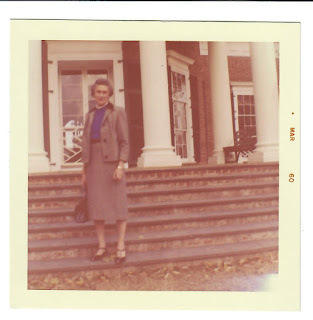 Fran Lewis at Monticello in 1960
Fran Lewis at Monticello in 1960Three years ago, Harley’s son Richard Lewis sent me two pages of the memoir in which his grandmother described visiting Monticello as a child with her siblings and parents. A few weeks ago, Richard kindly sent me the entire memoir and a short essay Fran wrote about visiting Monticello in 1908 when she was 15.
Whatfollows are excerpts about the family and Monticello that weren’t in the June2020 post or in SM. Fran wrote in the memoir that her father,L. Napoleon Levy, “came from a large and colorful family,” noting that one ofthe most colorful characters was her grandfather Jonas Levy, one of Uriah’sbrothers. She was right about the mercurial Jonas Levy, who spent most of hisadult life, as Fran put it, as a sea captain. She went on describe what theperipatetic Jonas Levy (1807-83) did after running away from the family home inPhiladelphia at 13 and showing up in New York City where his mother, Fanny, wasvisiting other family members.
Fanny Levy didn’t take kindlyto her young son making his way from Philadelphia to New York and “boxed hisears,” as Fran put it. So young Jonas abruptly left, but didn’t go back home. Instead,as family lore had it, he signed up as a cabin boy, Fran wrote, on “a sailingboat bound for S. America and was not seen by his family for 7 years.”
Fran Lewis then went on todescribe her Uncle Jeff in not exactly flattering words. For one thing, shesaid that the lifelong bachelor had little use for his young nieces duringvisits with their parents. When the family showed up at Jefferson Levy’s largetownhouse on East 34th Street, she said. “I don’t think he was atall interested in greeting” us, Fran remembered. And although her uncle was “avery wealthy man in those days, we never received anything of value from him orany gifts on birthday days.”
She pointed out that UncleJeff was “entirely different from my father,” even though the brothers practicedlaw together and were real estate investor partners. One example: L. NapoleonLevy thrived in the New York real estate business, while his brother, aboom-and-bust speculator, died about $2 million in debt.
Fran went on to say that she’dheard that her father wrote most of Jefferson Levy’s speeches during his threeterms as a Congressman from NYC, and that Uncle Jeff’s grammar was “poor.” Shesaid he always “gave the impression of being a [VIP], which he probably was.Especially in the Waldorf Astoria, where he was well known and where he gavemany lavish parties.”
***************
Fran Lewis wrote an essay she called “The Approach to Monticello” when she wasa student at the all-girls Jacobi School on the Upper West Side, founded in1896 by Laura Jacobi, now known as the Calhoun School.
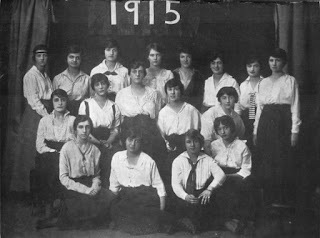 Jacobi School for Girls Class of 1915
Jacobi School for Girls Class of 1915In the essayshe evocatively describes what happened after she and her family arrived bytrain in Charlottesville from New York City for a visit to Monticello in June 1907.
As the train pulled “slowly out ofthe Charlottesville station,” young Fran wrote, “a large phaeton, drawn by apair of fine beautiful horses,” pulled up to take them to Monticello. Thefamily piled in and the open carriage made its way through the town (or“village,” as Fran put it) of Charlottesville and then onto a “very rough,muddy road” on the outskirts of town. Writing in the present tense, she notedthat the carriage “rattles and jolts over the ruts and stones.”
A few mileslater, as the sun was setting over the Blue Ridge Mountains, the carriage beganto climb up to Monticello. Just as they started up the steep road, the carriagecrossed a “quiet and peaceful” small creek and Fran remembered times when itwas “a roaring torrent, carrying great trees and small huts along with it.”
The road was better that day, but“very steep” and a “heavy pull” for the “strong Virginia horses.” On the wayup, they encountered a hay cart drawn by a pair of oxen driven by an olderAfrican American man who smiled and tipped his cap as they passed.
The horsessoon grew “tired and thirsty,” she wrote, so the carriage stopped and they drankthe “clear, cold water coming form a natural spring” on the side of the mountain.
The Levyssoon reached Monticello’s “pretty brick” Gate House, tended by Eliza ToliverColeman, whom Fran called “Aunt Liza,” and who swung “back the great gates forus to pass through.”
Then came a scaryride up a “curved and steep” road aside “a seemingly bottomless ravine” on theway to the house. Eliza had rung the large Gate House bell, “telling travelerson the top of the mountains not to go down,” Fran said, “as it is very dangerous for two vehicles to pass on such a narrow road.”
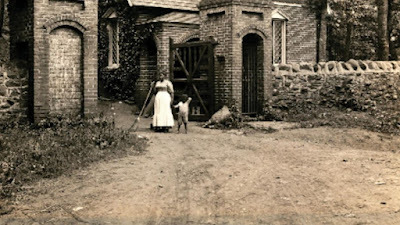 Eliza Coleman and a child at the old Monticello Gate House
Eliza Coleman and a child at the old Monticello Gate HouseAs theyneared the Jefferson Family cemetery (visitorsthen drove up to the house the opposite way they do now; that is, passing by thesmall graveyard before driving along Mulberry Row). silence “dropped overeverything,” Fran wrote, “never have I heard such stillness. The echo of thehorses’ hoofs on the stony road and the occasional cry of a peacock are theonly sounds.”
They passed the graveyard, where the headstones “looked white and ghostly”in the twilight. Then the refreshed horses ran “quickly across the lawn”heading for the East Front of the house. “Through the windows the soft light ofthe lamps seems to welcome us,” Fran wrote.
“We go onpast the rustic [long gone] fence, and the sweet scent of the honeysuckle whichis twined around it, is blown gently towards us. We give a long whistle. Thedogs begin to bark and an answering whistle comes back. On we go around thelarge lawn.
“Thecarriage stops in front of the great mansion; we are quickly helped to alightand taken up the long lawn. The doors of the house are thrown open, showing theGreat Hall inside, and we enter amid the barking of the dogs and hearty greetingsof the family.”
Fran Lewis, her sister Agnes, and their cousin Monroe Levyon the West Lawn during an earlier visit, circa 1902
DR. KAMENSKY: The Thomas Jefferson Foundation announced in Octoberthat Jane Kamensky will become the organization’s next president, startingJanuary 15 next year. Dr. Kamensky, aHarvard history professor who also directs Schlesinger Library on the Historyof Women in America at Harvard Radcliffe Institute, is just the secondhistorian to lead the nonprofit that has owned and operated Monticello since1923, and the second woman to hold that position.
Dr. Kamensky taught at Brandeis University and Brown University before joiningHarvard’s History Department.
Dan Jordan, a former historyprofessor at Virginia Commonwealth University, headed the Foundation from 1985-2008;Leslie Greene Bowman succeeded Dr. Jordan and resigned in April. GardinerHallock has been serving as interim President since then.
“We are thrilled to welcomeDr. Kamensky, who shares our belief that Monticello plays a pivotal role inilluminating the enduring ideals and contributions of Thomas Jefferson andtelling the stories of those who built and worked at this incredible World HeritageSite,” said Tobias Dengel, who chairs the Foundation’s Board of Trustees. “Dr.Kamensky brings more than 30 years of deep expertise as a distinguishedacademic at some of the world’s leading institutions and has displayed acontinued commitment to civic education and engagement to bring people together.”
We hope to have an interview withDr. Kamensky (below) in next month’s newsletter. It’ll focuse on her take on the historyof the house after Thomas Jefferson died—not coincidentally, the topic of SavingMonticello.
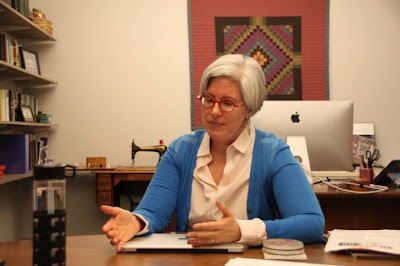
HUNTLAND: My new book, Huntland: The Historic Virginia Country House, the Property, and ItsOwners, has just been printed and copies are being shipped to theUniversity of Virginia Press, which will begin marketing and distributing thebook by the end of the month. My tenth book, it’s my second house history,along the lines of Saving Monticello.
Huntland, in Middleburg, Virginia, was built in1834, and has lots of history, memorable owners and visitors (including LyndonJohnson when he was Senate Majority Leader and Vice President), and atriumphant 21st century historic preservation story.
The book will be availableonline at U-Va. Press’s website and through local bookstores. Meanwhile, here’sthe link for the U-Va. Press Fall Catalog with more info about the book: https://bit.ly/U-VaPressHuntland
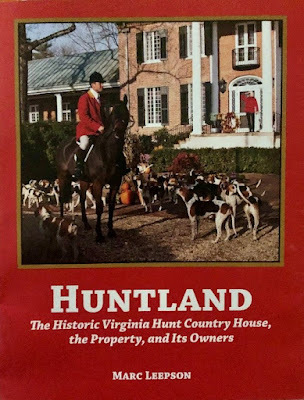
EVENTS: Still hard at work on my next book, the slice-of-life biography ofDoug Hegdahl, the lowest-ranking and youngest American captured in NorthVietnam and held prisoner there during the Vietnam War. So, no events thismonth. For details on future talks, check the Events page on my website: https://bit.ly/NewAppearances
GIFT IDEAS: For a personally autographed, brand-new paperback copy of Saving Monticello, please e-mail marcleepson@gmail.com I also havea few as-new, unopened hardcover copies, along with new copies of my otherbooks: Flag: An American Biography;Desperate Engagement; What So Proudly We Hailed; Flag: An American Biography; and Ballad of the Green Beret.

